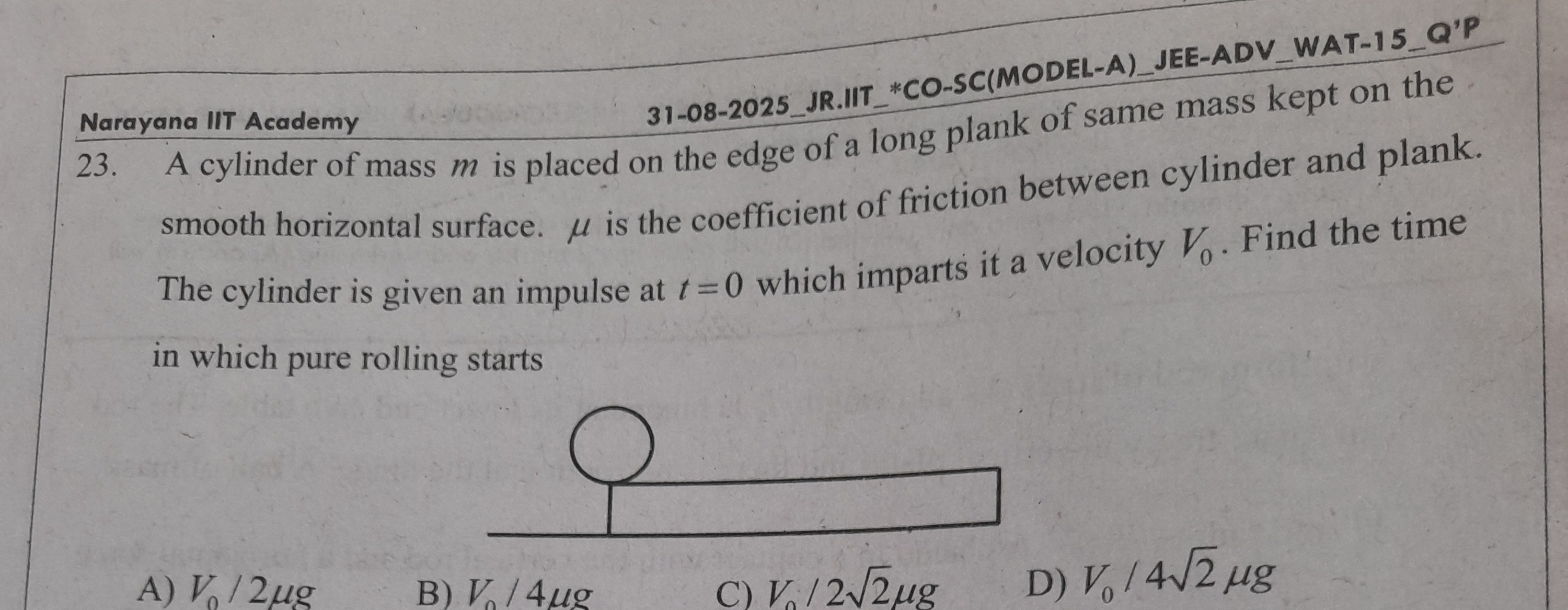Question
Question: A cylinder of mass $m$ is placed on the edge of a long plank of same mass kept on the smooth horizon...
A cylinder of mass m is placed on the edge of a long plank of same mass kept on the smooth horizontal surface. μ is the coefficient of friction between cylinder and plank. The cylinder is given an impulse at t=0 which imparts it a velocity V0. Find the time in which pure rolling starts

V_0/2μg
V_0/4μg
V_0/2\sqrt{2}μg
V_0/4\sqrt{2}μg
V_0/4μg
Solution
Let V0 be the initial velocity of the cylinder. Let m be the mass of the cylinder and the plank. Let μ be the coefficient of kinetic friction. Let r be the radius of the cylinder. The moment of inertia of a solid cylinder about its axis is I=21mr2.
When the cylinder is given an impulse, it starts sliding on the plank. The friction force between the cylinder and the plank is kinetic friction, fk=μN, where N is the normal force. For the cylinder, N=mg. Thus, fk=μmg.
Applying Newton's second law to the cylinder's center of mass: mac=−fk=−μmg ac=−μg The velocity of the cylinder's center of mass at time t is: vc(t)=V0+act=V0−μgt
The friction force on the plank is equal and opposite to the friction force on the cylinder. So, the friction force on the plank is to the right: map=fk=μmg ap=μg The velocity of the plank at time t is: vp(t)=vp(0)+apt=0+μgt=μgt
The friction force on the cylinder causes a torque about its center of mass. The friction force is to the left, at a distance r below the center of mass, causing a clockwise torque. τc=fkr=(μmg)r The angular acceleration is: αc=Iτc=21mr2μmgr=r2μg Assuming clockwise angular velocity as positive. ωc(t)=ωc(0)+αct=0+r2μgt=r2μgt
Pure rolling starts when the velocity of the point of contact of the cylinder with the plank is the same as the velocity of the plank. The velocity of the point of contact on the cylinder relative to the ground is vcontact,c=vc(t)−rωc(t) (since ωc is clockwise). vcontact,c=(V0−μgt)−r(r2μgt)=V0−μgt−2μgt=V0−3μgt
For pure rolling, vcontact,c=vp(t): V0−3μgt=μgt V0=4μgt t=4μgV0
